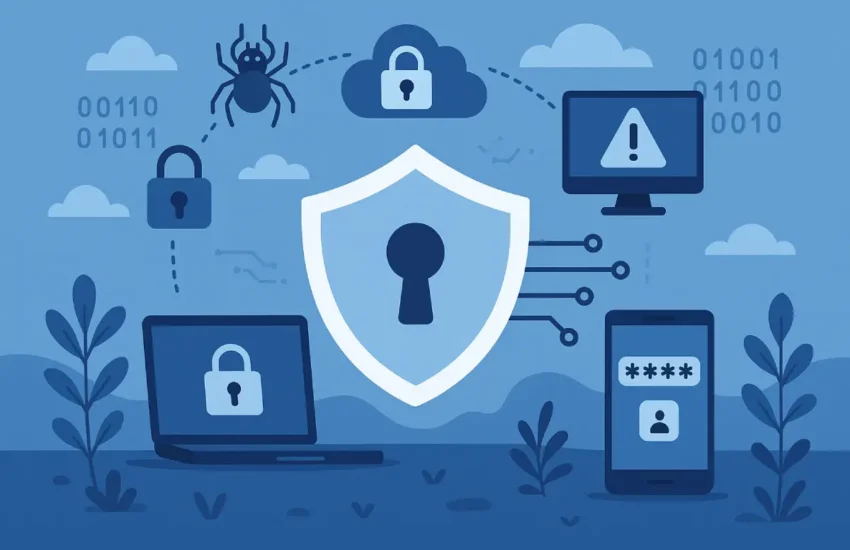Penetration Testing Tools for Vulnerability Detection Simulation and Defense
In today’s cybersecurity strategies, effectively simulating vulnerabilities requires reliable penetration testing tools. They simulate real-world attacks, reveal hidden vulnerabilities, and help teams refine defenses before malicious actors can cause harm. These solutions also encourage collaboration between security analysts and developers, ensuring resilient architectures. Because the cyber threat environment evolves daily, it’s crucial to stay aware of the latest methods and practices.
Contents
- 1 Ethical hacking tools in modern threat landscapes
- 2 Web application testing and why it matters
- 3 Harnessing network security tools for deeper visibility
- 4 Leveraging exploit frameworks for practical simulation
- 5 Penetration testing software and incident response
- 6 Targeting endpoints with refined strategies
- 7 Embracing cloud and hybrid environments
- 8 Social engineering and human-based attacks
- 9 Moving toward consistent security improvement
Ethical hacking tools in modern threat landscapes
Ethical hacking tools serve a pivotal role in exposing security gaps across various systems. They show how an attacker might breach networks, allowing organizations to redesign their defenses. By employing these resources, teams can engage in ongoing improvement and avoid outdated tactics. When combined with regular risk assessment tools, ethical hacking tools deliver deeper insights that help security teams strengthen every layer of defense.
Technologies that simulate adversarial tactics also make it easier to prepare for unexpected events. Scripts, frameworks, and automated penetration testing tools highlight the most common methods hackers use. Professionals can then leverage security testing tools to pinpoint misconfigurations in real time. This ensures that issues within complex infrastructures are addressed swiftly.
Web application testing and why it matters
Web application testing stands out as a central piece of a robust defense strategy. Modern applications often contain thousands of pages and rely on intricate code, which increases the likelihood of bugs and misconfigurations. Regular checks with penetration testing software can uncover hidden flaws that invite serious exploits. Developers and testers must collaborate to patch vulnerabilities and maintain a safer online environment.
Through specialized web application testing tools, organizations pinpoint cross-site scripting, SQL injections, and other dangerous flaws. The result is not just compliance with regulations, but also peace of mind for users who trust your infrastructure. Combining these tools with vulnerability assessment approaches keeps applications hardened against emerging attacks.
Harnessing network security tools for deeper visibility
A well-protected network demands continuous oversight, which is why network security tools are integral to any proactive effort. They offer insight into traffic flow, identify suspicious activity, and enable administrators to monitor data exchange across a variety of endpoints. By integrating advanced solutions like network scanning tools, professionals create an environment that spots threats before they escalate.
As part of a holistic approach, intrusion detection tools complement scanning capabilities for real-time monitoring. This layered mindset isolates irregular behavior early and bolsters defenses whenever vulnerabilities appear. Through such specialized security auditing tools, organizations gain a clear understanding of network traffic patterns, offering a more robust safety net for operations and data.
Strengthening wireless segments
Wireless network testing tools add a crucial next layer of scrutiny. These resources examine wireless protocols to spot insecure configurations that could allow unauthorized access. In an era of widespread mobile computing, ignoring wireless issues can be costly. Addressing them directly with thorough inspections remains an essential measure.
Leveraging exploit frameworks for practical simulation
Exploit frameworks allow ethical hackers and security professionals to replicate attacks in a controlled environment. They reconstruct tactics used by cybercriminals, from zero-day vulnerability tools to more common methods like phishing. With these frameworks, teams can see firsthand how malware analysis tools identify malicious code. This intelligence drives defensive strategies, guiding administrators toward more customized responses.
Reverse engineering tools also come into play. Analysts examine malicious executables, deconstruct potential exploits, and share findings with their colleagues. These proactive measures prevent certain zero-day attacks from spreading uncontrollably. By pairing exploit frameworks with open source penetration testing tools, teams stay agile in how they detect and respond to evolving threats.
Gaining insight from manual techniques
Automation saves time, but manual penetration testing techniques often uncover subtle issues missed by scripts. Experienced testers rely on their intuition, guided by their familiarity with exploitation tools and patterns. This personal approach allows a more nuanced perspective, yielding higher certainty that a system is truly secure.
Penetration testing software and incident response
Penetration testing software integrates a variety of features—from scanning modules to advanced reporting functions—helping analysts navigate complex security challenges. Through data collection and correlation, these platforms expedite the process of identifying entry points. They also tie in well with incident response tools, ensuring that once vulnerabilities are found, well-defined actions follow.
When teams pair software-based tests with security assessment solutions, they see how different segments of an organization line up against regulatory demands. Compliance testing tools confirm requirements are met, allowing businesses to avoid penalties. Whether it’s a government agency or a startup, an approach grounded in robust software helps maintain forward momentum.
Addressing compliance demands
While threat detection comes first, meeting legal and industry obligations remains vital for long-term success. Businesses of all sizes must consider frameworks that align with their sector. Penetration testing tools empower leaders to demonstrate compliance, offering proof that security protocols are actively enforced throughout.
Targeting endpoints with refined strategies
Endpoint security testing tools shed light on how well laptops, desktops, and mobile devices resist malware. Because these endpoints frequently operate outside secure office networks, they can serve as entry points for attacks if left unguarded. An internal breach can spread quickly and lead to widespread compromise.
To address this threat, organizations pair password cracking tools with firewall testing tools as part of their standard audit process. Working with security auditing tools designed for endpoints reveals hidden flaws in device configurations. By identifying oversights, teams can fine-tune policies that eliminate or reduce the risk of unauthorized access.
Why password security matters
Weak credentials remain a top cause of data breaches. Imaging or remote-work solutions can be used to target employees, leading to unauthorized entry if passwords can be easily cracked. With targeted password cracking tools, testers highlight the problem of simplistic user passwords. This awareness reshapes security steps to emphasize strong passphrases, periodic rotations, and multi-factor authentication whenever feasible.
Embracing cloud and hybrid environments
With so many operations migrating to remote and hybrid setups, cloud penetration testing tools have become pivotal. They uncover misconfigurations in virtual machines, containers, and data storage. If left unobserved, these vulnerabilities can compromise sensitive data in the blink of an eye. From configuration checks to assessing shared responsibility models, the cloud ecosystem requires specialized solutions.
Using automated penetration testing tools that focus on virtual environments makes scaling more seamless. Security teams handle sprawling infrastructures without sacrificing visibility. Adopting black box testing tools for dynamic scanning can further strengthen defenses by simulating external attackers who have limited knowledge of the system.
Shielding data in virtual layers
With virtualization on the rise, providing safe storage and data handling should remain top tier for every company. Virtual machines must be configured properly to avoid privilege escalation. Searching for overlooked aspects helps prevent data leaks that could devastate organizational reputation. Ongoing penetration tests on cloud layers also ensure services stay aligned with best practices.
Social engineering and human-based attacks
No discussion about security is complete without covering social engineering tools. Hackers frequently target human behavior, tricking individuals into sharing credentials or installing harmful software. In-depth trainings supplemented by controlled simulations help employees resist common tactics, such as phishing schemes and pretext calls.
Open source penetration testing tools often include modules for social engineering. These modules automate various tests, ranging from orchestrated phishing campaigns to calls that prompt users to reveal personal data. The best risk assessment tools balance technical testing with human-based training. By addressing both the system and the people who manage it, organizations tackle security from every angle.
Incident handling after infiltration
Should an attacker succeed in bypassing gatekeepers, incident response tools guide the recovery process. These resources help coordinate tasks—isolating compromised devices, gathering forensic data, and restoring normal operations. Proper preparation ensures minimal downtime and a clearer path to future improvements. This cyclical process adapts to the ever-changing nature of cyber warfare.
Moving toward consistent security improvement
Cyber threats shift constantly, and organizations must adapt to outmaneuver each new wave of exploits. Teams refine their processes by comparing current procedures to best practices and updating controls as needed. Ongoing engagement with exploitation tools, network scanning tools, and vulnerability assessment tools keeps defenders in a proactive stance. Each round of testing brings fresh insights that make future attacks harder to accomplish.
Practical security testing happens when a mix of technology, technique, and human skill converge. Whether you rely on open source penetration testing tools or enterprise-grade penetration testing frameworks, mixing automation with hands-on expertise is essential. It’s how teams spot overlooked backdoors, calibrate defenses, and maintain a secure posture in the face of continuous threats.
Organizations that stay committed to expanding their capabilities cultivate a robust defense culture. Continuous attention to cloud penetration testing tools, zero-day vulnerability detection, and firewall optimization ensures harmful incursions see fewer points of entry. As businesses layer social engineering tools, reverse engineering methods, and advanced scanning into their arsenal, they create a future-resistant stance that better withstands subtle and aggressive attacks alike.
Through steadfast attention and regular testing cycles, cybersecurity efforts remain fluid and responsive. Each new vulnerability discovered becomes another lesson that shapes tomorrow’s defenses. In a digital world demanding agility, penetration testing tools and related security solutions ensure that every angle—human or technological—receives the scrutiny it deserves.



